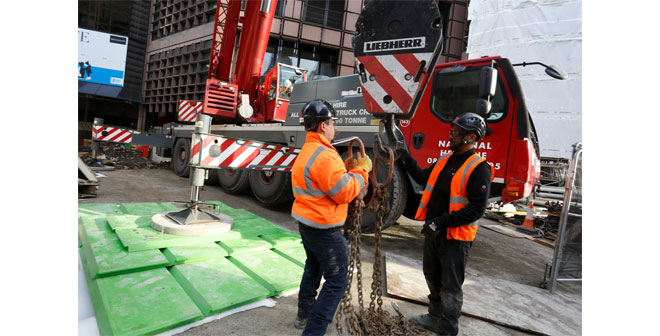
Solum - Construction sites have been identified as a significant contributor to air pollution in major cities. In September 2015, the Greater London Authority introduced new regulations to control the emissions from construction equipment across the capital.
Important as these regulations are, they are minimum standards and the more progressive construction companies have sought to go further and seek innovative solutions to help cut emissions.
Solum, a multi-purpose aluminium temporary foundation for the construction industry is one such innovative solution helping specialist contractor Keltbray Group reduce on-site emissions.
Steve Leyton, Group Lifting Operations Manager for Keltbray, takes up the story: “We are involved with a lot of major projects across the UK, including London and typically our work requires the continuous use of large mobile cranes.
“To lift heavy loads safely, cranes must deploy outriggers and it’s essential they spread the load evenly. In the past, the largest cranes required heavy steel plates for the outriggers to sit on, but these often required a second crane to be used on site to lift them into place.
“The Solum foundations are modular and spread working loads over an increased footprint. But importantly, they are the perfect balance of strength and load capacity compared to their weight, which means even the largest unit can be moved by hand.
“Solum can be delivered with the crane and set out by hand in just a few minutes, saving all the emissions associated with the second crane. The speed with which the outrigger foundations can be set up also saves hours of emissions from the crane with it on site for less time thanks to Solum.
“Keltbray takes its responsibilities to reduce emissions from site equipment very seriously and understand every little helps. Specifying Solum for all our crane operations demonstrates our commitment to reducing the need for additional equipment when man-handling will get the job done more quickly and help lower emissions.”
Solum (Europe) Limited, Business Development Director Roger Tice commented: “This is a good day for Solum. When we created the product, our intention was to offer a product that not only out-performed similar outrigger mats or pads, but was light enough to be moved by hand.
“The specification was more about increasing safety and reducing the effort needed on site to produce a stable foundation for cranes, whilst helping them avoid the un-safe practice of short-rigging to lift their own foundations into place.
“To have achieved all that and discover being able to man-handle the units into place in minutes, is a major contributor to reducing emissions from major construction sites, is very gratifying and makes all the effort worthwhile.
“With emissions regulations only likely to get tougher, I’m confident that whilst Keltbray is the first to specify Solum for all its crane lifting operations, it will only be the first of many.”
London Mayor Sadiq Khan recently announced his intention to introduce an ultra-low emission zone in central London from 2020, following estimates that the non-road mobile machinery (NRMM) used on construction sites was responsible for 12% of NOx emissions and 15% of PM10 emissions in Greater London